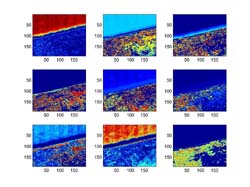
The work is reported as cover story in a recent issue of the Digital Signal Processing: A Review Journal .

A recent study by Huang Deshuang and his colleagues from the CAS Hefei Institute of Intelligent Machines has shed new light on the development of digital image processing technology. Their work has been reported as a cover story in the July issue of the
Digital Signal Processing: A Review Journal .
Multispectral imaging entails acquiring several images of the same scene using different spectral bands. For instance, a digital color camera can detect three separate images from the red, green and blue components of light. Collecting several spectral bands generally provides more information than would be obtained from a single monochrome image. This idea has been applied in the field of remote sensing technology for over 20 years.
Feature extraction is a key step for classification, which is a very important task for scene interpretation and other applications of multispectral images. By extracting more nonlinear features than the corresponding number of linear features in original feature space, classification accuracy for multispectral images can be greatly improved. To resolve the problem of multispectral images, Prof. Huang and his colleagues proposed a new preprocessed approach on the basis of the fuzzy c-means clustering (FCMC) and kernel principal component analysis (KPCA). By using this method, some color multispectral data from a 7-band remote sensor in a U2 reconnaissance airplane obtained from George Washington University were addressed. The experimental results show that it is an effective and efficient method for analyzing the multispectal images.
It is a good approach when FCMC and KPCA are put together in a dual integration, which can lead to a big-margin decrease in the computing workload, comments experts. More importantly, the approach can effectively pick up weak signals from the remote-sensing image and remarkably improve the nonlinear image's quality. The research results are applicable to environmental protection, farming production estimate, monitoring the territorial resources as a forceful tool in image processing, providing theoretical grounds for decision makers in related governmental departments.
Experts say that the approach could have a wide application in image processing technology and provide powerful tools for environment and resource monitoring. At present, Dr. Huang is leading his research team to go on with more new advances in treatment of telemetric images and intelligent computing technology. It can be expected that more advances in this field will be achieved by this research team in the future.








